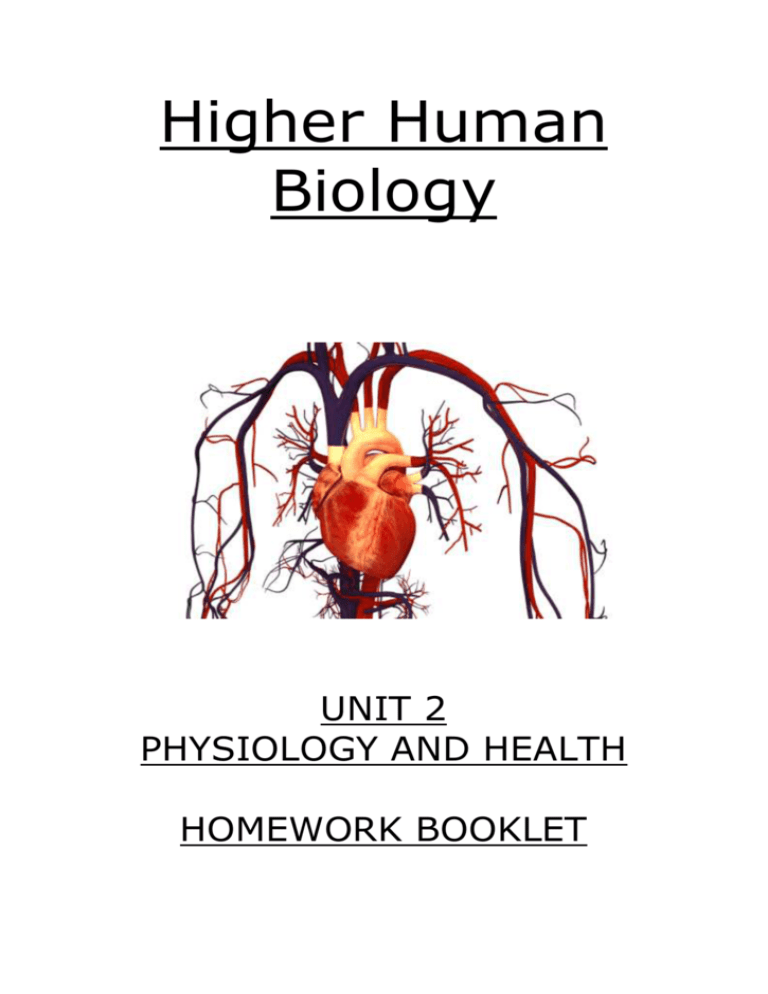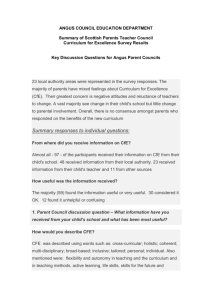Unit 2 Homework Booklet
advertisement

Higher Human Biology UNIT 2 PHYSIOLOGY AND HEALTH HOMEWORK BOOKLET Higher Human Biology (CfE) Homework – Reproductive Organs 1. Label parts A – K of the reproductive system (11) 2. Select one/two letters from the above diagram to identify the following: a. b. c. d. Produces constituents of Semen Passage of urine out of the body Site of gamete production Site of fertilisation (4) 3. State the names of specific site of gamete production in: a. Males b. Females (2) 4. State the function of prostaglandins and fructose present in semen (2) 5. Name the process of cell division which produces gametes (1) TOTAL – 20 Higher Human Biology (CfE) Homework – Hormonal Control of Reproduction 1. When does the production of sex hormones occur and what triggers this? (2) 2. Name the gonadotrophic hormones and their site of production in: a. Males b. Females 3. Where are the following hormones produced: a. Oestrogen b. Testosterone c. FSH d. ICSH (2) (2) 4. Using the above diagram: a. b. c. d. e. f. Name the structure labelled 2 Name the process occurring at stage 4 The surge of which hormone triggers stage 4? Name the structure labelled 5 Name the hormones released by structure 5 Which hormone is produced by structure 5 but not by structure 2? (6) 5. Why does the lining of the uterus broken down if there is not pregnancy? (1) 6. Why does the maturation of a new graffian follicle not occur if an egg has been fertilised? (1) TOTAL – 14 Higher Human Biology (CfE) Homework – Fertility Control 1. Why is female fertility said to be cyclical whereas males are said to be continuously fertile? (1) 2. What is the main reason that females may fail to ovulate and explain why Poor Nutrition and Pituitary Gland failure would cause this? (3) 3. How would artificial insemination help a man with low sperm count have a baby with his partner? (1) 4. How have the chances of IVF success been increased with the use of new technology ICSI (intracytoplasmic sperm injection) (1) 5. Explain what happens to the many embryos produced during IVF (1) 6. a. A parent of a child being produced by IVF treatment is concerned that their child may inherit Cystic Fibrosis because it runs in their family. What type of testing would be carried out on the embryo? (1) b. Give two reasons why the result of this procedure might have an impact on the childs future (2) 7. Describe how one form of: a. Barrier contraception prevents fertilisation (1) b. Sterilisation technique prevents fertilisation (1) c. IUD prevents fertilisation (1) 8. Describe how methods of contraception prevent fertilisation and explain the difference between ‘morning after’ and ‘mini’ pills. (5) TOTAL – 18 Higher Human Biology (CfE) Homework – Ante and Post-natal Screening 1. How does ultrasound technology work? (1) 2. What type of scan would be carried out at the following stages and what would be checked for? a. 11 weeks b. 19 weeks (1) (1) 3. Which hormone is used as a normal indicator of pregnancy? (1) 4. If a pregnant woman took a pregnancy test at three weeks and had an HCG level shown as an X on the graph. What type of result would she get and why? (2) 5. What is produced from the results of Amniocentesis and what can it be used to detect? (2) 6. What is sampled in: a. Amniocentesis b. CVS (2) 7. Why would a second rhesus positive baby be at risk in a rhesus negative mother? (2) 8. What type of disorder is shown in each diagram and give a reason for your choice: (Black is recessive, White is dominant phenotype) a. (1) b. (1) TOTAL – 14 Higher Human Biology (CfE) Homework –Transport Systems 1. Why does a Human need transport systems whereas a bacteria does not? (1) 2. State the three components of the Cardiovascular system (1) 3. Why do arteries have thick muscular layers? (3) 4. Which feature is present in Lymph vessels and veins but absent in arteries and capillaries. Explain the how this feature works and its purpose. (3) 5. With the aid of a diagram explain how materials are exchanged at capillary beds. (5) 6. How is flow maintained in the lymphatic system? (1) 7. State three functions of lymph nodes (1) 8. Explain with examples how oedema can occur (3) TOTAL – 18 Higher Human Biology (CfE) Homework – Structure and Function of Heart 1 1. Label the parts A – H from the above diagram (8) 2. Use one or more letters from the above diagram to answer the following questions: a. Which part(s) prevents backflow of blood from the pulmanory artery into the right ventricle (1) b. Which part(s) would have contact with deoxygenated blood? (1) c. Which part(s) are veins? (1) d. Which part(s) brings oxygenated blood back to the Heart? (1) e. Which part(s) connect the heart to the body? (1) f. If blood is returning from the body place the letters the blood would pass through in the correct order to the point of blood leaving the heart to return to the body (1) 3. Which blood vessel supplies the heart muscle with blood? (1) 4. Which ventricle of the heart is the thickest and why? (1) 5. If an individual has a resting heart rate of 70 bpm and a stroke volume of 55ml, what is their cardiac output? (1) 6. How would the resting cardiac output of a trained athlete differ and give two reasons why? (2) Questions 7 and 8 refer to the diagram above. 7. Explain what the terms Systole and Diastole mean (1) 8. From the information above: a. Calculate the individials heart rate (bpm) (1) b. Assuming they have a stroke volume of 60ml, calculate the individuals cardiac output. (1) 9. What can abnormal patterns of sound coming from the heart indicate? (1) TOTAL – 23 Higher Human Biology (CfE) Homework – Structure and Function of Heart 2 1. Which structure in the heart controls heart rate and where is it located? (2) 2. Describe the passage of nerve impulses through the heart during one complete cycle of contractions. (3) 3. Using information from the diagram below, explain how the brain would respond to an increase in physical activity in terms of heart rate. (5) 4. Explain why the two nerve pathways can be described as antagonistic. (1) 5. Explain what is happening at point P in the above ECG reading. (1) 6. Why is there two lines representing blood pressure in the Artery vessels in the above diagram? (1) 7. Why is blood pressure considerably lower in vein blood vessels than arteries? (1) 8. What name is given to long term increased blood pressure? (1) TOTAL – 15 Higher Human Biology (CfE) Homework – Cardiovascular Disease 1. With the aid of a diagram explain the principles behind atherosclerosis. (3) 2. Haemophiliacs suffer from a genetically inherited trait in which they do not produce a functional clotting factor known as factor 8. Explain why they would not be able to clot their blood at the site of an injury. You may use a diagram to help you explain this. (3) 3. What is a thrombus and how does it form? (2) 4. What is an embolus? (1) 5. State two major risk factors of cardiovascular disease and explain how they contribute to it. (2) 6. Explain how either: a. Deep Vein Thrombosis OR b. Pulmanory Embolisms Occurs and the symptoms of the condition (2) 7. Why is cholesterol an important molecule the diet? (2) 8. How does Low Density Lipoprotein differ from High Density Lipoprotein? (2) 9. Why is excess LDL not absorbed by body cells and where is it absorbed instead? (2) 10. Why is a high HDL to LDL ration preferable in the blood? (1) 11. What could be recommended for individuals who have high cholesterol levels in the blood? (3) 12. Why do sufferers of familial hypocholesterolaemia suffer from increased numbers of atheromas? (2) TOTAL – 25 Higher Human Biology (CfE) Homework – Diabetes and Obesity 1. Explain why the diabetic in the above diagram would have an increased blood glucose level following a meal, assuming that he suffers from type 1 diabetes (2) 2. Why would the reason be different if the person was suffering from type 2 diabetes? (2) 3. The diabetic in the above diagram is 57 years old. Which type of diabetes is the person likely to be suffering from and why? (2) 4. Why might a diabetic lose their sight later in life? (2) 5. Where is blood glucose concentration monitored? (1) 6. Which hormone(s) promote the breakdown of glycogen into glucose? (1) 7. Using the following table describe the health of a person who is 1.78m tall and 66 kg in weight. (1) 8. Other than BMI name two other techniques used to measure body composition. (1) 9. List three causes of obesity (1) TOTAL – 13




